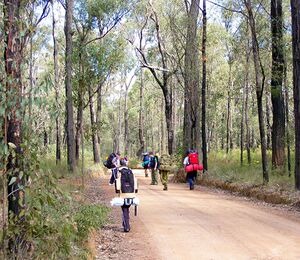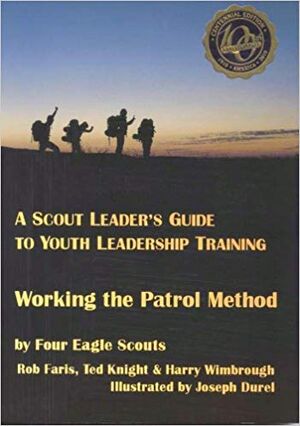The Patrol Method
- "Never do for Scouts what they can do for themselves!"
A Scout Patrol is a group of Boy Scouts who belong to the same troop and who are probably similar in age, development, and interests. The patrol method allows Scouts to interact in a small group outside the larger troop context, working together as a team and sharing the responsibility of making their patrol a success.
Scout Patrol
Each troop is divided into patrols of around five to ten Scouts. A patrol's independence from the troop varies among troops and between activities. For instance, a troop typically holds ordinary meetings as a unit. Patrols' autonomy becomes more visible at campouts, where each patrol may set up its own area for cooking and camping. However, on a high adventure trip which only a small part of the troop attends, divisions between patrols may disappear entirely. Patrols may hold meetings and even excursions separately from the rest of the troop, but this is more common in some troops than in others. Each patrol has a Patrol Leader (PL) or Assistant Patrol Leader (APL). Some troops mix older and younger Scouts in the same patrols, so that the older Scouts can teach the younger ones more effectively, other troops group Scouts by age, so that the members of one patrol have more in common.
A patrol takes pride in its identity, and the members strive to make their patrol the best it can be. Patrols will sometimes join with other patrols to learn skills and complete advancement requirements. At other times they will compete against those same patrols in Scout skills and athletic competitions.
The members of each patrol elect one of their own to serve as Patrol Leader. The troop determines the requirements for patrol leaders, such as rank and age. To give more youths the opportunity to lead, most troops elect patrol leaders twice a year. Some may have elections more often.
Patrol size depends upon a troop's enrollment and the needs of its members, though an ideal patrol size is eight Scouts. Patrols with fewer than eight Scouts should try to recruit new members to get their patrol size up to the ideal number
Patrol Method
“The patrol’s a small team of eight or so Scouts, and it’s more than organizational convenience or a Boy Scout version of the den. It’s the place where boys learn skills together, take on leadership responsibilities, perhaps for the first time, and develop friendships that will last over a lifetime.” (Mark Griffin, previously team leader of Learning Delivery for Scouting University and now an area director in the Central Region.)[1]
Patrol Method Examples
Examples of Patrols using the Patrol Method:
- patrol leader report on what happened at the latest patrol leaders’ council meeting
- Patrol plans upcoming outings, including food menus
- Patrol Designs patrol flag
- Patrol Outfit and clean patrol box
- Patrol Works on advancement requirements
- Patrol Plays a game or have fun in some way
- Patrol Leader comes to Patrol Meeting with an agenda and a plan.
What does the patrol leader do?
- Plans, organizes, conducts patrol meetings activities.
- Represents the patrol as a member of the patrol leader’s council.
- Keeps patrol members informed about upcoming events and deadlines.
- Encourages patrol members to complete advancement requirements
- Sets a good example by living up to the Scout Oath and Law
Examples that you might have it wrong:
- Court of Honor: Adults show up 15 minutes early and scurry about setting up the room, chair, flags, refreshments, decorations, etc.
- Outdoor activity{ Instead of leaving the planning and logistics to the patrols, the adults plan the meals, buy the food, arrange transportation and recruit drivers, help the Scouts set up their tents, and so on.
Special Patrols
- Service Patrol:
- Spirit Patrol:
- Honor Patrol:
Resources
- "a Troop is not divided into Patrols. A Troop is the sum total of its Patrols." — William "Green Bar Bill" Hillcourt
- "The patrol method is not a way to operate a Boy Scout troop, it is the ONLY way. Unless the patrol method is in operation, you don't really have a Boy Scout troop. ” — Robert Baden-Powell
Handbook For Boys 1953
Here are some excerpts from the BSA HANDBOOK FOR BOYS (Fifth Edition, 1953)…
“You do your part in the Patrol when you do your best to live up to the Scout Oath, the Scout Law, and the Motto and Slogan. This makes you a better Scout yourself, and you set an example for others. When they see that you are living up to the spirit of Scouting, you help them to be better Patrol members.
“You do your part in the Patrol at meetings, hikes, and camping trips. You may be selected for a Patrol job: such as Patrol Leader or Assistant, Scribe, Treasurer, Cheer Leader, or Hikemaster; or may help the Scout who has one of these jobs.
“”You may know where a Patrol Good Turn is needed, and help to carry it through.
“You may think of a new kind of hike…or a new place to go.
“Patrol activities are decided upon by all members of the Patrol.
“When you have learned a few Scouting skills…you can help your Patrol Leader train other Scouts in your Patrol. This will help you too, for there is nothing like teaching others to help you learn a subject yourself.
“A Patrol is a group who are good friends and who can work and play together as a team. (Your Patrol) has a name, its own officers, and much of the fun you find in Scouting will be with…your Patrol.”
References
See Also
- A Scout Leader's Guide to Youth Leadership Training: Working the Patrol Method - This guide offers practical advice about the "Why" of the Patrol Method; the Patrol Method from a Scoutmaster's perspective; team-building and shared leadership; how to create your personal leadership legacy, and much more.
- Ask Andy About Patrols - NetCommissioner Ep #589.
- A Beginner's Guide to the Patrol Method - Bryan on Scouting (05-Sep-2014)
- Patrol Method Dos and Donts - NcacBSA.org

